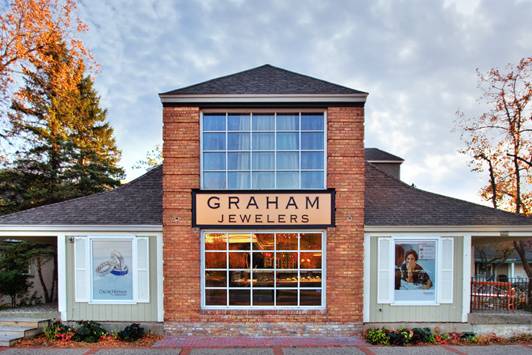
Getting rave reviews is nothing new for Chris Graham, president of Graham Jewelers in Wayzata, Minnesota. But now the still-favorable reviews reflect a Covid-19-inspired reality.
“Customers are talking about how safe they feel in the store [in terms of the virus]. I could never have imagined a review like this only a few months ago,” he says.
Graham, who purchased the store in 2004, explains that 2019 had been his best year since the 2008 recession, a trend he expected would continue into 2020. Then Covid-19 hit. The result was a “roller coaster” of stops and starts. Following the almost eight-week state-mandated shutdown, the shop temporarily did curbside selling before reopening. However, there was a second 10-day shutdown that necessitated boarding up the store as a precaution against the looting in Minneapolis, about 20 minutes away.
Fortunately, the store was not in the looters’ path. However, curbside pickup was a “disaster,” according to Graham. From the vantage point of a few weeks later, he describes the scenario with a mix of exasperation and humor, recalling one case of a customer who wanted a ring sized. “There I was trying to measure the size while kneeling awkwardly in front of the customer, who was sitting in the driver’s seat. My glasses kept fogging up because of the mask. I ran back and forth from the store to the parking lot so many times to complete the transaction that people thought the store was open and randomly walked in, completely ignoring the curbside rule.”
Keeping busy
Even though personal selling was basically at a standstill, Graham focused on business during the lockdown. In addition to using funds from the government’s Paycheck Protection Program (PPP) to rebuild the store’s website, “we also figured out how to make something out of nothing using scrap gold and scrap diamond melee. Our goal was to create $100,000 worth of jewelry at retail. We did it,” he declares proudly.
Intent on providing a safe and comfortable shopping environment, he focused on taking precautions that would allay customers’ concerns. “They have a high level of awareness, and we have to meet their expectations,” he notes. He installed plexiglass dividers to separate customers and sales staff, who are required to wear masks. For the very few customers who wouldn’t succumb to peer pressure to don a mask, Graham placed boxes of them on the counters with a sign: “No need to ask. Please take a mask.”
Once everything settled down, he saw “great sales” and clients returning to the store, which is located in a boutique neighborhood shopping district known as the “Rodeo Drive of the Midwest.”
“We are a destination store,” he explains. “Now more than ever, customers are hunting — they know what they want.”
Bridal is one of the strongest categories in the shop, which features non-branded goods. The average center stone is between 1 and 1.25 carats, usually set in a yellow gold ring that sells in the $5,000 to $10,000 range. Halos remain popular, even though brides often say they don’t want the same halo their friends have. “And then,” comments Graham, “they choose the halo.” He has also observed increased sales of heavier solitaires measuring about 3 millimeters.
New clientele
While bridal was the first segment to return, Graham identified a new customer category: the “moms and grandmas” coming in to buy high school and college graduation gifts, spending on average between $500 and $1,000 for their daughters and granddaughters who couldn’t have a party or ceremony. In fact, Graham says, “our new customer count has been higher than it has ever been.”
One invaluable resource for Graham has been a peer group of 10 jewelers in non-competing markets around the country. As a member for 15 years — he joined shortly after buying the store — he says the group helped him stay in business through all the hard times. “All of us were in a similar situation. But everyone was in a different phase of the lockdown, with different rules applying. I was able to listen to someone who had shut down two weeks prior to us and ask, ‘How did you handle this problem?’ or ‘What did you do?’”
On the bright side
Graham thinks it’s too early to assess the lessons learned, since he is “still learning.” But he was struck by how quickly the world could shut down. Now that it’s happened once, he’s concerned that “it can happen a second time for whatever the next crisis is.” Still, he looks back to a lesson from the recession in 2009: “In a time like this, bridal, custom, estate and repair have staying power. They are recession-proof, and we are focusing on that, and that is how it is playing out.”
Graham sees other rays of hope as well. “This has been the first shining light in the small brick-and-mortar business in a very long time. Who wants to go to a crowded mall even when they open? I think customers would much rather shop where there is less foot traffic and density. The play for the small, independent brick-and-mortar jewelry store is stronger than ever.”
In addition, he continues, “we are in the middle of what is probably the biggest worldwide social experiment ever. During this time, people discovered how important family and the people close to them are. Personal connections that were lost have been restored. The significance of giving meaningful gifts has come back through that process.”
And plenty of those connections have been romantic ones. “During this time, young kids fell in love. Hopefully, couples married 20, 30 or 40 years rediscovered why they fell in love in the first place. I feel good about that. That’s the business we’re in.”
grahamjewelers.comArticle from the Rapaport Magazine - August 2020. To subscribe click here.